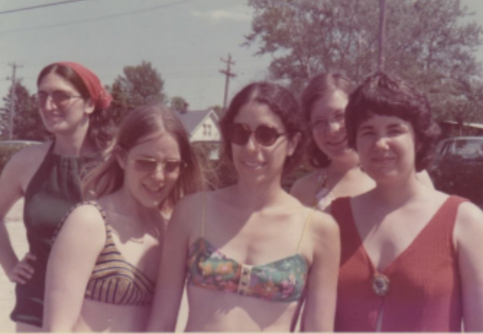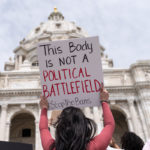
Growing up, Emma Pildes had always heard stories about the Janes.
Her father’s first wife had once been a member of the women-led group that performed illegal (but safe) abortions in a pre- Roe v. Wade Chicago. The scheming that made their operations possible was like something out of a Nancy Drew novel, from speaking in code on the phone to driving on back roads so they wouldn’t be tailed by detectives.
Pildes, who has been producing documentaries for nearly 20 years, had always said she would be happy to direct a film if something moved her to do so. That “something” was the Janes. Members of the group performed an estimated 11,000 abortions before seven members were arrested in 1972. The passing of Roe v. Wade the following year prevented them from being charged and put an end to the Janes entirely – but the remarkable tale lived on for years.
In 2022, Pildes finally chronicled it in “The Janes,” her Oscar-shortlisted documentary released on HBO. “I felt a responsibility to be the one to tell it,” Pildes said. “My brother Daniel is one of the producers, so it’s a family affair that we’ve dragged a bunch of people into.”
One of those people was director and activist Tia Lessin. Pilnes approached her with the idea in the summer of 2018, right around the time Justice Brett Kavanagh was to be confirmed. Both women knew if pro-life justices were to dominate the Supreme Court – as promised by former president Donald Trump in a 2016 debate – federal abortion rights would be in trouble.
“It felt like this was the time to revisit the story,” said Lessin, who had learned about the Janes in a gender studies class at Cornell in the 1980s. She agreed to co-direct the film with Pildes, who would also produce it. In January 2020, they began interviewing former members of the Janes.

Some of the women had stayed friends, according to Pildes, but others had moved on with their lives and gone separate ways. Many women had never even met. And while some were immediately willing to sit in front of a camera and share their stories, others needed some convincing. “It’s a highly stigmatized, complex, controversial subject matter,” Pildes said. “I’m grateful they were willing to sit with us and tell their stories, and that they saw things the way we did – the necessity to get this story out.”
The women’s interviews were paired with footage found in local news archives. The videos of women speaking at rallies and getting arrested en masse was, for Lessin, “a looking glass into these current times,” as many women and doctors today face prosecution for terminating pregnancies.
Back then, when 30 states criminalized abortion under all circumstances, not all women who needed abortions had the means to travel to places like “New York City in 1972, before that to California and Hawaii, before that to Tijuana and London and Japan” for legal abortions, according to Lessin. Many women – predominantly Black women – were forced to turn to self-imposed or back alley abortions. The Janes closed this gap by allowing women to pay whatever they could – it was a common practice for patients to “pay it forward” and help cover abortion costs for others who needed it.
Learning about this inequity “helped us to connect dots to the current situation, or what was going to be the situation, with abortions,” Pildes said. “When you bring [abortion law] down to a state-by-state level, people have to travel to receive basic health care. It’s limited to people who can travel and take days off work, that can afford childcare, that have a car, that are old enough – whatever the case may be, there are people who are able to get this health care, and there are people who are not.”
This fact rang truer than ever as Pildes and Lessin traveled around the country for film screenings and women in the audience shared their own stories. One woman stood up and said her grandmother died from a back alley abortion because she didn’t have access to a safe one. Another woman said she had a friend in high school who put on her brother’s football helmet and threw herself down the stairs in hopes of trying to get rid of an unwanted pregnancy.
“We’ve seen the film open up conversations where people can talk about things that maybe they’ve never told anyone because they’ve been too ashamed, or maybe because they just haven’t been asked,” Lessin said. She even heard stories from women who were forced to give birth and defer other dreams they had – “Who knows how their lives might have been different?”
Because the film premiered at Sundance in January 2022 – five months before the Supreme Court’s Dobbs v. Jackson Women’s Health Organization decision, which overturned Roe v. Wade – Pildes and Lessin saw firsthand how reactions to the film evolved as the events of the film began to reflect real life. “As the year progressed, people started to awaken,” Pildes said. “As people started to awaken, the questions changed and the emotions changed.”
The world changed, too. In the months following the Dobbs decision, women all over the country have been denied care from doctors who are afraid of prosecution. In December, the Commonwealth Fund reported higher maternal mortality rates – especially among women of color – in states that ban or restrict abortions due to a shortage of maternal and reproductive care. While some fear our country is heading back to pre-Roe times, others fear we’re heading somewhere worse – with omnipresent state surveillance of pregnant women and doctors through period-tracking apps, search histories and location data.
Pildes said the film “paints a picture of what this country looked like 50 years ago, when women didn’t have a right to choose and didn’t have proper, safe, legal access to abortion.”
They still don’t. ◼



